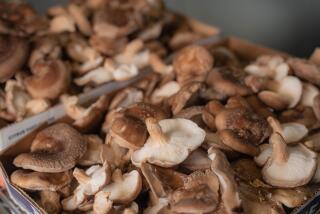STORAGE : An Ounce of Prevention Weighs Against Moths
- Share via
Moths don’t cause damage, but their larvae do.
Adult clothes moths are buff or yellowish in color and have a wingspan of about one-half inch. Females lay eggs in clothing and other fabrics; larvae hatch from the eggs and feed on the fabric.
Fully grown larvae are one-half-inch long white worms with dark heads. They feed not only on clothing but on blankets, rugs, carpets, drapes, pillows, upholstery and brushes. They feed on any item made of wool or other natural fiber.
To battle moths in storage areas, keep areas clean, dry, free of insects and away from light, which can promote hatching of insect eggs. Moderate, even cool, temperatures and humidity are best. Avoid extremes such as a hot attic or a damp basement.
Prepare the storage area by vacuuming thoroughly, especially in floor cracks and crevices. Empty the cleaner bag immediately after use. It may contain eggs, larvae or adult moths. Then sprinkle mothballs, flakes or crystals according to manufacturer’s directions.
Because mothballs and crystals emit a vapor that is heavier than air, also suspend some in containers above the clothing. Old stockings or socks make good bags for mothballs. Or sprinkle moth crystals on the sticky side of masking tape and hang them.
Mothballs, flakes or crystals are poisonous, so don’t scatter them where children or pets can reach them.
Mothballs and crystals won’t kill moth eggs that are already present in wool, other natural fibers or fur. Launder or dry-clean garments made of these materials to destroy the eggs before storing.
A more time-consuming and less effective method is to air the garments in the sun.
Shake them vigorously and brush them well on both sides, turning out pockets, seams and linings. Soft or napped fabrics are likely to harbor the eggs even after this treatment.
Store clean clothes in sturdy cardboard boxes, plastic garment bags with zippered closings, or clean trash cans with tight lids. Sprinkle moth flakes or crystals inside the containers, following label directions or use moth repellent cakes. But don’t store leather and fur garments in airtight containers; they need to “breathe.”
You can use moth-repellent substitutes for mothballs. If you can’t find sachet bags, make your own out of cheesecloth, clean baby socks, old clean nylon stockings or pantyhose.
Fill these with any combination of cedar chips, dried lavender, aromatic pipe tobacco, whole peppercorns or a 50-50 mixture of dried rosemary and mint. Try a pet store for cedar chips; a health food store should carry the herbs.
Moths appear to hate newsprint, so try packing out-of-season clothing in newspapers. Garments on hangers can be wrapped in several layers of newspapers with all openings sealed with strong tape. Roll newspapers inside rugs before storing them.
Cedar chests and closets will keep out moths only if they have no gaps or open seams, and if made of cedar heartwood at least three-quarters of an inch thick. Seal the closet door with weatherstripping and a cedar chest with felt gasketing to make them airtight.
Although cedar will kill newly hatched or young worms, it won’t kill eggs, half-grown worms, the pupae or chrysalis enclosed in cases or cocoons, or moths.
Try cedar in your other closets and chests. It’s nonpoisonous and comes in blocks, chips, shavings, hangers and drawer liners.

